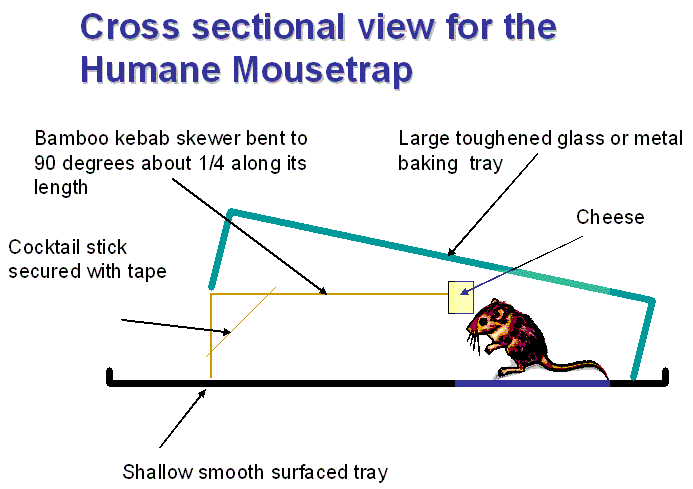
Steve Smith's World Famous Mousetrap
This information, along with a picture gallery and quicktime movie of the trap in action, can also be found at Steve's personal website http://www.smithsax.btinternet.co.uk/. Check it out!
Nobody wants to share their home with a wild mouse, but many of us do not wish to cause them pain and suffering as we remove them. Commercial mousetraps usually lead to an agonizing and slow death, and poisons are even worse. I have developed a simple, reliable mousetrap which will work every time and will never hurt the mouse.
THE BENEFITS OF THE HUMANE MOUSETRAP
- Free - you can make it yourself from items that are found in your home
- Safe - it cannot do harm to the mouse or poison your family and pets
- Effective - it seems to work every time
- Environmentally friendly - all the components can be recycled
- Adaptable - it also works for rats and other rodents
WHAT YOU WILL NEED
- A large, smooth surfaced, low sided tray
- A deep, rectangular baking tin of slightly smaller size made of glass or metal
- A bamboo kebab skewer
- A cocktail stick
- Adhesive tape
HOW TO BUILD IT

- Take the bamboo skewer and bend it through 90 degrees approximately 1/4 of the way along its length. Do not snap it completely.
- Fix the 90 degree bend so it is rigid by attaching a cocktail stick with adhesive tape.
- Place a small piece of cheese or peanut butter on the long end of the skewer. Alternatively use a bent coat hanger which works just as well.
- Place the baking dish open side down on the tray and prop it up with the skewer as shown in the diagram. This may take a little practice. Curved dishes roll to the side so a square edged dish is essential. IMPORTANT - do not prop it up too high - just enough for the mouse to get under. If it is too high there is a chance the mouse will get underneath it as it falls and be injured.
- A mouse can easily enter the space under the dish to get the bait but as soon as he touches it the dish falls and traps him. He cannot be injured as the bait is well away from the falling edge.
- The tray and dish, with trapped mouse can be taken to a distant location and the mouse can be released without injury.
TIPS
You can stabalise the dish to stop it rolling by putting a little bit of bluetac or plastecine between it and the tray.
If the trap has been activated and there is no mouse caught check that the dish is heavy enough to secure the captive. If in doubt set the trap with a book placed on top of the dish.
Take the mouse a good distance away from home before releasing it. I recommend at least a mile.
If you scale up the apparatus for rats then a book - or a house brick - will be essential.
Be careful when releasing rats as they can be aggressive. Do not release them in an enclosed space. Allow them an obvious direction to escape away from you.
Check how the mice got into your house in the first place. Many will enter through open doors and windows which can be closed. Make sure that skirtings and under floor areas are sealed or you will be taking rodents away for ever.